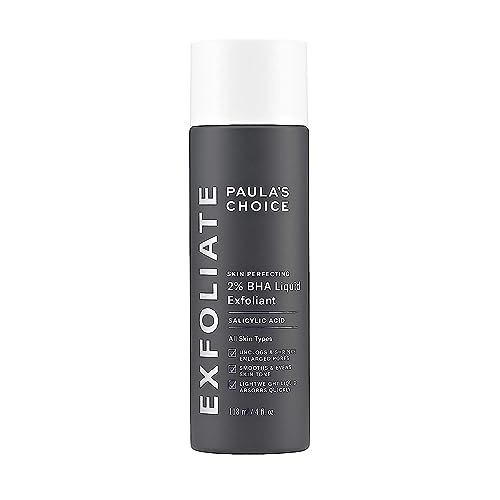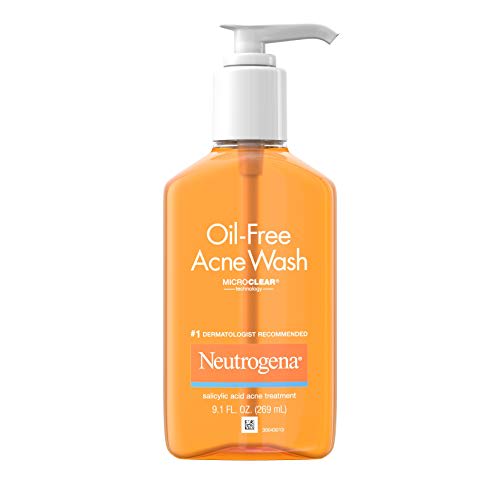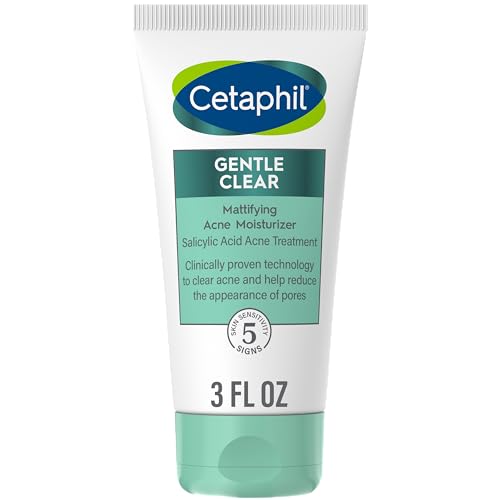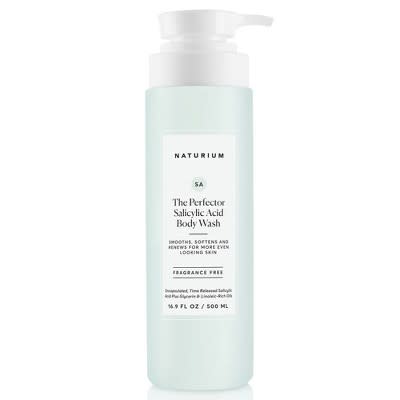With abundant skin care products targeting acne, oil and dead skin, you may need help picking one out. We recommend taking a glance at the ingredient list to narrow the selection down. If salicylic acid is at the top of the list, then you can expect the product to help treat oily and acne-prone skin, exfoliate and remove dead and dull skin.
We spoke to dermatologists about salicylic acid, its benefits and the dos and don’ts of using this ingredient. We also compiled a list of salicylic acid products to incorporate into your skin care routine. As our beauty reporter at NBC Select, I have spent hours researching and testing the best skin care products.
Selected.
Show 2 More
Show Less
SKIP AHEAD How we picked the best salicylic acid products | Best salicylic acid products | What are the benefits of salicylic acid?
What is salicylic acid?
Salicylic acid is a beta hydroxy acid (BHA) commonly used for chemical exfoliation, according to Dr. Hadley King, a board-certified dermatologist in New York City. It’s derived from the bark of the willow tree, but it can also be synthesized in a laboratory, says Idriss. They dissolve the bonds that hold dull, dead skin cells on the skin’s surface so the skin will gently shed, revealing smoother, brighter skin underneath. Unlike water-soluble alpha hydroxy acids (AHAs), BHAs are oil soluble, so they can work on the skin’s surface and inside your pores, says King.
Want more from our everyday experts, straight to your inbox? Sign up for The Selection, our weekly newsletter packed full of good finds, sales and exclusive content.
How we picked the best salicylic acid products
Although salicylic acid treatments are available at your dermatologist’s office or clinics, there are over-the-counter (OTC) options. When shopping for a product containing salicylic acid, our experts recommend considering the following:
- Formulation. Salicylic acid can be found in many products, including cleanser, toner, serum, spot treatment and more. Whichever formulation you choose depends on your personal preference. For example, if you want to target specific areas, you’ll be more likely to choose a spot treatment. It also depends on your current skin care routine because some formulations may require nightly use only or may not mix well with other active ingredients.
- Concentration. The higher the concentration, the more potent the product, according to Dr. Nkem Ugonabo, a board-certified dermatologist. The maximum percentage of salicylic acid in OTC products is 2%, according to Dr. Ryan Turner, a board-certified dermatologist.
- Price: Since salicylic acid is available in drugstore products, many affordable options exist.
The best salicylic acid products, tested and approved
Below, we rounded up our experts’ and editors' favorite products containing salicylic acid.
Best overall: Paula’s Choice Skin Perfecting 2% BHA Liquid Exfoliant
This liquid exfoliant is recommended by Turner and Chiu because it’s one of the most effective products for exfoliation and addressing skin clarity and tone. It has humectants and antioxidants to not only hydrate and protect the skin but also to help improve the efficacy of the salicylic acid since it helps product absorption, according to the brand.
Best cleanser: Neutrogena Oil-Free Acne Wash
This daily cleanser is recommended by Dr. Annie Chiu, a board-certified dermatologist in California, and Dr. Marisa Garshick, a board-certified dermatologist in New York, because it has 2% salicylic acid. The face wash is gentle enough to use twice daily to help reduce blackheads and breakouts while preventing new ones from forming, according to Garshick.
Best moisturizer: Cetaphil Gentle Clear Mattifying Acne Moisturizer
This moisturizer, which has 0.5% salicylic acid, is excellent for oily and acne-prone skin because it won’t leave the skin looking or feeling greasy since it has a natural matte finish, says Garshick.
Best body acne treatment: Neutrogena Stubborn Body Acne Treatment Spray
A spray form of salicylic acid can be beneficial, particularly for people who deal with breakouts on the body and aren’t able to shower right after physical activity, says Ogunabo. With 2% salicylic acid, the quick-drying and fragrance-free spray can clear and prevent acne-prone areas of the skin, including your chest and back, according to the brand.
Best for sensitive skin: Glow Recipe Strawberry Smooth BHA + AHA Salicylic Serum
If you have sensitive skin, this serum from Glow Recipe may be the best option since it has encapsulated salicylic acid, which will help decongest your pores, reduce excess oil and, most importantly, minimize irritation, says Garshick. It also has AHAs, including mandelic, azelaic and succinic acid, which are gentle on the skin, making them suitable for sensitive skin, according to Garshick.
Best for reducing redness: The Ordinary Salicylic Acid 2% Solution
If you want to target and treat your acne, try this water-based salicylic acid serum, says Chiu. The serum penetrates your pores to clear them and improve their appearance by reducing the size of blemishes and visible redness, according to the brand. For the most effective results, use this at night after cleansing and before adding your moisturizer, according to The Ordinary.
Best nighttime treatmentDrunk Elephant T.L.C. Framboos Glycolic Resurfacing Night Serum
This Drunk Elephant serum is recommended by board-certified dermatologist Dr. Blair Murphy-Rose because it has salicylic and glycolic acid. The raspberry extract also found in this serum helps clean pores, soothe the skin and target fine lines, according to Murphy-Rose.
Best serum: SkinCeuticals Blemish + Age Defense
To treat adult acne and reduce the appearance of fine lines, consider this serum recommended by Chiu, Garshick and Turner. The serum has 1.5% salicylic acid to help with oil and breakouts, but it also has glycolic acid and citric acid to address fine lines and help smooth skin, according to our experts.
Best body wash: Naturium The Perfector Salicylic Acid Skin Smoothing Body Wash
This fragrance-free wash comes recommended by Ugonabo because it gently exfoliates the face and body, leading to a softer feeling. It has encapsulated salicylic acid to help maintain pH levels, smooth skin, and decongest pores while leaving it without any dryness or irritation, according to the brand.
Other salicylic acid products our experts love
CeraVe Acne Control Cleanser
This acne wash has 2% salicylic acid to help reduce breakouts and gently exfoliate the skin, in addition to oil-absorbing hectorite clay to reduce clogged pores, says Garshick, who also adds that the ceramides and niacinamide keep your skin from feel dry. Our editorial director, Lauren Swanson, has used this cleanser for years and loved how gentle it was.
La Roche-Posay Effaclar Medicated Gel Facial Cleanser
This 2% salicylic acid cleanser helps combat acne breakouts and oil control, according to board-certified dermatologist Dr. Nkem Ugonabo. It’s great if you have sensitive skin because glycerin is a main ingredient, which hydrates the skin by absorbing water, according to the brand.
The Inkey List Beta Hydroxy Acid Serum
This formula has 2% salicylic acid, hyaluronic acid and zinc to help control oil and reduce inflammation, according to Turner. If you have normal, oily or combination skin, try using this serum daily during your nighttime skin care routine, according to the brand.
SkinMedica AHA/BHA Cream
This cream helps improve skin texture, tone and smoothness, according to Chiu. It combines salicylic acid with ingredients like lactic and glycolic acid to help exfoliate and reduce the appearance of fine lines and dull skin. According to the brand, it has vitamin B5 (panthenol) and vitamin E to moisturize and protect the skin.
Dove Body Love Acne Clear Body Cleanser
This body wash is great for preventing body acne and is cost-effective relative to the size, says Ugonabo. The gel wash has 1% salicylic acid to exfoliate and treat acne-prone skin and ingredients like glycerin so that your body doesn’t feel tight, dry and uncomfortable after your shower, according to the brand. It also leaves your body with a subtle, clean and herbal scent, according to Dove.
How to shop for salicylic acid products
When shopping for salicylic acid products, our experts recommend looking for ones that fit your skin care routine and are effective without being irritating. Below, our experts share a few tips to remember when shopping for one.
Paired ingredients. Salicylic acid is usually paired with other ingredients, so look at the ingredient list while shopping. Dryness and irritation is common when using a chemical exfoliant, so it’s important to find moisturizing and anti-inflammatory ingredients. Some examples of these ingredients are hyaluronic acid, ceramides and niacinamide, according to experts. More on what ingredients to combine and what to avoid are below.
Concentration. Regarding salicylic acid, over-the-counter products range in concentration from 0.5% to 2%, says board-certified dermatologist Dr. Shereen Idriss. A concentration from 0.5% to 1% is typically found in cleansers and toners, whereas 2% is often used in spot treatments and targeted treatments, according to Idriss. If you’re just now introducing your skin to salicylic acid, start with lower concentrations and gradually increase to avoid irritation, says Chiu. If your skin can tolerate higher concentrations, consider using products that have 2% (the highest concentration allowed as regulated by the FDA) salicylic acid, according to Ugonabo.
pH level. You may notice some labels indicating the pH level when purchasing salicylic acid products. If possible, try products with a pH between 3 and 4 for optimal effectiveness, says Chiu.
Formulation. Salicylic acid products come in different formulations, including cleansers, toners, spot treatments, serums and more. In general, it may come down to personal preference and individual skin care concerns regarding which is most suitable, according to Garshick. If you’re looking for targeted treatment, consider gels, spot treatments or serums, says Chiu. According to Chiu, moisturizers, cleansers and toners may be best for those who want a more widespread application.
What are the benefits of salicylic acid?
Salicylic acid has a few benefits, so you might want to begin using them. Chiu breaks down a few key benefits of the popular skin care ingredient.
- Exfoliation. Salicylic acid helps remove dead skin cells, unclog pores, and prevent acne.
- Anti-Inflammatory. Its anti-inflammatory properties effectively reduce redness and inflammation associated with acne.
- Oil Control. Salicylic acid helps regulate oil production, which can help those with oily or combination skin.
- Blackhead and Whitehead Control. It helps control blackheads and whiteheads by penetrating deep into the pores.
Frequently asked questions
Who should and should not use salicylic acid?
According to Turner, salicylic acid is a comedolytic, which helps “break up” and resolve open comedones (blackheads and whiteheads). Because of this, our experts recommend using it if you have normal to oily, acne-prone skin. If you want to exfoliate your skin, you can also use salicylic acid since it can help remove dead and dull skin, says Turner.
If you have sensitive skin, are pregnant or breastfeeding or have any skin conditions like rosacea , you may want to consult with your dermatologist about whether or not salicylic acid is safe for you, according to our experts.Depending on your skin's tolerance to formulation and usage, you may find yourself benefiting from salicylic acid’s anti-inflammatory and skin-calming properties, says King. However, if you have sensitive or extremely sensitive skin, you may want to be cautious since you may experience irritation, according to our experts.
If you are allergic to salicylates, you should altogether avoid it, says Chiu. Or if you have a known allergy to aspirin, you should also avoid it as much as possible, according to Turner.
How often can you use salicylic acid?
If you are just now incorporating salicylic acid into your routine, start with gentle exfoliation once or twice weekly, according to King. You can then adjust your frequency (or the concentration) if you notice your skin is not irritated or dry after using it, according to King.
If you have oily and acne-prone skin, you may even be able to use a salicylic acid-infused cleanser daily since the cleanser will only stay on the skin for a few minutes tops, says Turner. If you have those skin types and have a high tolerance, you can also use a salicylic acid serum or spot treatment daily, according to Turner.
However, those with more sensitive skin may want to limit their use to a few times a week instead of daily, as overuse could irritate the skin, says Turner.
When does salicylic acid fit into a skin care routine?
It’s fine to use them either in the morning or nighttime, says Chiu. However, if you decide to use a variation of this acid in the morning, follow it with sunscreen , according to Chiu, since it can make your skin more sensitive to sun exposure. Although wearing sunscreen daily is essential, it’s especially important when using chemical exfoliants since you don’t want to damage your skin while trying to treat it, says Turner.
What ingredients can you use with salicylic acid?
Because chemical exfoliants like salicylic acid can be drying and irritating sometimes, finding other skin care ingredients to help balance those effects is essential.
- Humectants. This type of ingredient helps hydrate the skin by attracting water, therefore increasing moisture, according to experts. One of the main humectants to consider using with salicylic acid is hyaluronic acid, says Turner. Emollients . Since salicylic acid can disrupt the skin barrier, you want to find emollients (ingredients that support the skin barrier) to help, says Turner. Consider incorporating skin care products with ceramides (a type of emollient), according to Turner.
- Sunscreen. Exfoliation can make your skin more sensitive to the sun, so protect your skin from UV light by using an SPF, says King.
- Antioxidants. Antioxidants help protect from free radical damage, says Chiu. While salicylic acid works primarily at the skin's surface, antioxidants can offer protection at a deeper level. This means that the duo will address current issues, such as acne, while preventing potential future damage from environmental stressors, according to Chiu.
- Anti-inflammatories. BHAs work well with vitamin B3, also known as niacinamide, since they both have anti-inflammatory properties, according to our experts. Niacinamide helps soothe and hydrate the skin and reduce discoloration, says Turner. Using them together may heighten the results of your acne treatment while reducing potential side effects, according to Turner.
What ingredients should you avoid combining with salicylic acid?
If possible, avoid using products containing benzoyl peroxide and vitamin C simultaneously as salicylic acid, as they may increase irritation, says Chiu. Also, using retinoids or AHA with your salicylic acid may sensitize the skin since each ingredient can already be irritating, according to Turner. However, suppose a product combines salicylic acid with another irritating ingredient. In that case, they are already balanced and are safe to use, but still proceed with caution and conduct a patch test to see how your skin reacts.
Although you don’t want to mix all these active ingredients in one setting, you can still use them at some point. Separate them into use in the morning versus night or use them on different days, says Turner.
How long does it take to see the benefits of salicylic acid?
According to our experts, you may notice a difference in your skin immediately after one salicylic acid application. However, significant improvement in clogged pores and acne should be visible within a month, and you should see full results in two to three months, says King.
What are the harms of salicylic acid?
You have to be careful not to overdo it, says Idriss. In general, exfoliation should be reserved a few times throughout the week. However, if you’re using a salicylic acid cleanser for oily or acne-prone skin, you can get away with using it daily, according to Idriss.
Meet our experts
At NBC Select, we work with experts with specialized knowledge and authority based on relevant training and/or experience. We also ensure all expert advice and recommendations are made independently and without undisclosed financial conflicts of interest.
- Dr. Marisa Garshick is a board-certified dermatologist in New York City and a clinical assistant professor of dermatology at Cornell.
- Dr. Hadley King is a board-certified dermatologist at her own private practice in New York City. Her areas of expertise include medical and cosmetic dermatology.
- Dr. Ryan Turner is a board-certified dermatologist in New York City. His areas of expertise include cosmetic dermatology, general dermatology, surgical dermatology and laser surgery.
- Dr. Nkem Ugonabo is a board-certified dermatologist in New York City. Her areas of expertise include medical and cosmetic dermatology, lasers, injectables, acne and hyperpigmentation.
- Dr. Annie Chiu is a board-certified cosmetic and general dermatologist and founder of The Derm Institute in Redondo Beach, California. Her areas of expertise include non-invasive cosmetic dermatology and aesthetics.
- Dr. Shereene Idriss is a board-certified dermatologist and founder of Idriss Dermatology in NYC and is also the creator of the #PillowtalkDerm series on Instagram. Her areas of expertise include volume displacement, skin discoloration and textural changes of the skin.
Why trust NBC Select?
Bianca Alvarez is an associate reporter covering skin care and hair care, whose recent stories include roundups of the best body washes for sensitive skin and retinol alternatives. For this story, she interviewed experts and researched highly rated products containing salicylic acid that were in line with expert guidance.
{{data.menu.name}}
- {{#data.menu.menuItems}}
- {{text}} {{/data.menu.menuItems}}
Catch up on Select’s in-depth coverage of personal finance, tech and tools, wellness and more, and follow us on Facebook, Instagram, Twitter and TikTok to stay up to date.




